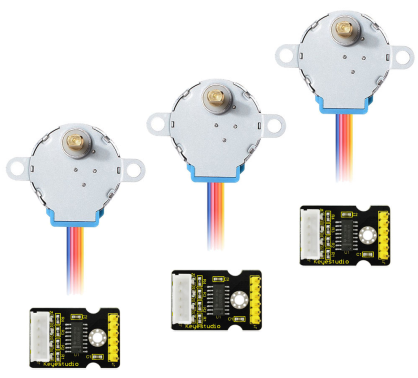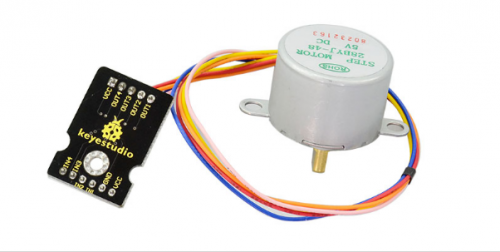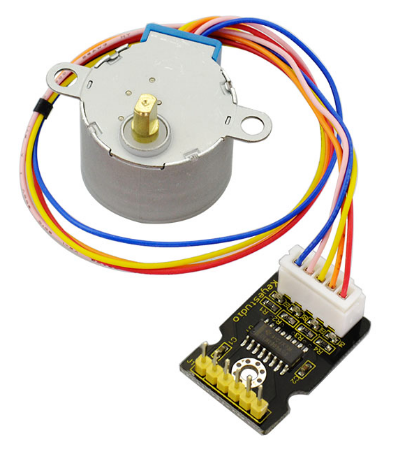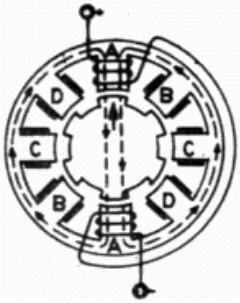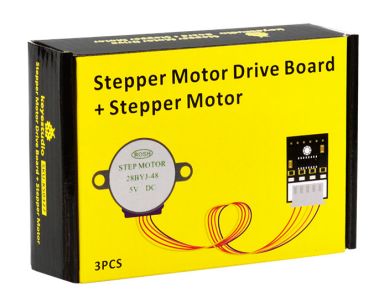KS0327 Keyestudio Stepper Motor Drive Board + 5V Stepper Motor Kit (3PCS): Difference between revisions
Keyestudio (talk | contribs) |
Keyestudio (talk | contribs) |
||
| (4 intermediate revisions by the same user not shown) | |||
| Line 4: | Line 4: | ||
<br>[[File:Ks0327图片1.png|500px|frameless|thumb]]<br> | <br>[[File:Ks0327图片1.png|500px|frameless|thumb]]<br> | ||
<br> | |||
== Overview == | == Overview == | ||
This kit mainly consists of three deceleration stepper motors (28BYJ-48) and three stepper motor(5-wire 4-phase) driver boards (ULN2003). Stepper motor driver board mainly adopts ULN2003 chip. It is a seven-fold Darlington array. This circuit is the inverted output type, that is, its output terminal can be turned on to work only by inputting a low-level voltage. Onboard comes with 4 LEDs, so in this way you can know the state of input control pulse. <br> | This kit mainly consists of three deceleration stepper motors (28BYJ-48) and three stepper motor(5-wire 4-phase) driver boards (ULN2003). <br> | ||
In the experiment, we connect the stepper motor to its driver board, and then connect the drive board to microcontroller. The interface is anti-reversed type, so do not worry about the wrong connection. | Stepper motor driver board mainly adopts ULN2003 chip. It is a seven-fold Darlington array. This circuit is the inverted output type, that is, its output terminal can be turned on to work only by inputting a low-level voltage. Onboard comes with 4 LEDs, so in this way you can know the state of input control pulse. <br> | ||
In the experiment, we connect the stepper motor to its driver board, and then connect the drive board to microcontroller. The interface is anti-reversed type, so do not worry about the wrong connection. <br> | |||
<br> | |||
== Details Display == | == Details Display == | ||
<br>[[File:Ks0327图片2.png|500px|frameless|thumb]]<br> | <br>[[File:Ks0327图片2.png|500px|frameless|thumb]]<br> | ||
<br>[[File:Ks0327图片3.png|500px|frameless|thumb]]<br> | <br>[[File:Ks0327图片3.png|500px|frameless|thumb]]<br> | ||
<br> | |||
== Deceleration Stepper Motor== | == Deceleration Stepper Motor== | ||
* Diameter: 28mm | * Diameter: 28mm | ||
| Line 20: | Line 21: | ||
* Stepping angle: 5.625 x 1/64 | * Stepping angle: 5.625 x 1/64 | ||
* Reduction ratio: 1/64 | * Reduction ratio: 1/64 | ||
<br> | |||
The stepper motor’s no-load power consumption is below 50mA, with 64 times reducer, and its output torque is relatively large, can drive heavy load, very suitable for the development board. <br> | The stepper motor’s no-load power consumption is below 50mA, with 64 times reducer, and its output torque is relatively large, can drive heavy load, very suitable for the development board. <br> | ||
'''Notice:''' Compared with those stepper motors without reducer, the rotation speed of this stepper motor with 64 times reducer is more slower, you can stick a small paper on its output shaft for convenient observation. | <span style=color:red> '''Notice:''' </span> <br> | ||
Compared with those stepper motors without reducer, the rotation speed of this stepper motor with 64 times reducer is more slower, you can stick a small paper on its output shaft for convenient observation.<br> | |||
<br> | |||
== Working Principle == | == Working Principle == | ||
<br>[[File:Ks0327图片4.png|500px|frameless|thumb]]<br> | <br>[[File:Ks0327图片4.png|500px|frameless|thumb]]<br> | ||
<br> | |||
=== One-phase Excitation Mode: === | === One-phase Excitation Mode: === | ||
That is, A-B-C-D each phase is powered up in sequence. When phase A is powered, due to attraction of the NS phase, the pole nearest to phase A on the rotor turns to the position of phase A. Then phase B is powered, the pole nearest to phase B on the rotor turns to the position of phase B. After that, both phase C and phase D are powered in turn, this way, the rotors can be continuously rotated. By sequentially powering the phase ABCD, so that achieve the rotors rotate continually. | That is, A-B-C-D each phase is powered up in sequence. When phase A is powered, due to attraction of the NS phase, the pole nearest to phase A on the rotor turns to the position of phase A. Then phase B is powered, the pole nearest to phase B on the rotor turns to the position of phase B. After that, both phase C and phase D are powered in turn, this way, the rotors can be continuously rotated. By sequentially powering the phase ABCD, so that achieve the rotors rotate continually. <br> | ||
<br> | |||
'''Key Points:''' <br> | <span style=color:red> '''Key Points:''' </span> <br> | ||
* 1)Stator: the fixed part of the motor is called stator, such as ABCD magnetic poles. | * 1)Stator: the fixed part of the motor is called stator, such as ABCD magnetic poles. | ||
* 2)Rotor: refer to the rotating part. | * 2)Rotor: refer to the rotating part. | ||
| Line 36: | Line 40: | ||
* 4)In the 1-2 phase excitation mode, the angle at which the rotor rotates at each step is called the Stepping Angle. In the one-phase excitation mode, the angle of rotor rotation per step divided by 2 is the Stepping Angle. | * 4)In the 1-2 phase excitation mode, the angle at which the rotor rotates at each step is called the Stepping Angle. In the one-phase excitation mode, the angle of rotor rotation per step divided by 2 is the Stepping Angle. | ||
<br> | |||
=== One-Two Phase Excitation Mode: === | === One-Two Phase Excitation Mode: === | ||
In other words, the mode of electrification becomes A-AB-B-BC-C-CA, and the principle is the same as that of 1-phase excitation. At different points, when AB is connected with electricity, the rotor turns to the place where the magnetic tension between phase A and B is the most strongest. | In other words, the mode of electrification becomes A-AB-B-BC-C-CA, and the principle is the same as that of 1-phase excitation. At different points, when AB is connected with electricity, the rotor turns to the place where the magnetic tension between phase A and B is the most strongest. | ||
<br> | |||
== Setting Method == | == Setting Method == | ||
'''Parameters of Motor:''' <br> | '''Parameters of Motor:''' <br> | ||
Voltage 5V; Step Angle 5.625; Reduction Ratio 1:64 | Voltage 5V; Step Angle 5.625; Reduction Ratio 1:64 | ||
<br> | |||
* 1.Calculate the angle at which A-B-C-D is powered on at one turn 5.625X2X4/64=0.703125 (2 means that the per step in 1-phase excitation mode is 2 times step angle; 4 means that it goes four steps; 64 refers to the reduction ratio of motor) | * 1.Calculate the angle at which A-B-C-D is powered on at one turn 5.625X2X4/64=0.703125 (2 means that the per step in 1-phase excitation mode is 2 times step angle; 4 means that it goes four steps; 64 refers to the reduction ratio of motor) | ||
* 2. The number of powering ABCD in 360-degree cycle is 360/0.7031=512 | * 2. The number of powering ABCD in 360-degree cycle is 360/0.7031=512 | ||
* 3. Wiring method: the output terminal A1, B1, C1, D1 of ULN2803 stepper motor driver are connected to the stepping motor's ABCD four phases respectively, corresponding to blue, pink, yellow, orange line. The red line is connected to VCC. The input pin header of ULN2803 driver are connected to to Digital port 8, 9, 10 and 11. The + and - pin are connected to the arduino's 5V and GND, respectively. You can refer to the connection diagram below. | * 3. '''Wiring method:''' the output terminal A1, B1, C1, D1 of ULN2803 stepper motor driver are connected to the stepping motor's ABCD four phases respectively, corresponding to blue, pink, yellow, orange line. The red line is connected to VCC. The input pin header of ULN2803 driver are connected to to Digital port 8, 9, 10 and 11. The + and - pin are connected to the arduino's 5V and GND, respectively. You can refer to the connection diagram below. <br> | ||
<br> | |||
== Connection Diagram == | == Connection Diagram == | ||
The output terminal A1, B1, C1, D1 of ULN2803 stepper motor driver are connected to the stepping motor's ABCD four phases respectively, corresponding to blue, pink, yellow, orange line. The red line is connected to VCC. The input pin header of ULN2803 driver are connected to to Digital port 8, 9, 10 and 11. The + and - pin are connected to the arduino's 5V and GND, respectively. You can refer to the connection diagram below. | The output terminal A1, B1, C1, D1 of ULN2803 stepper motor driver are connected to the stepping motor's ABCD four phases respectively, corresponding to blue, pink, yellow, orange line. <br> | ||
The red line is connected to VCC. The input pin header of ULN2803 driver are connected to to Digital port 8, 9, 10 and 11. The + and - pin are connected to the arduino's 5V and GND, respectively. You can refer to the connection diagram below. <br> | |||
<br>[[File:Ks0327图片5.png|1000px|frameless|thumb]]<br> | <br>[[File:Ks0327图片5.png|1000px|frameless|thumb]]<br> | ||
<br> | |||
== Driving Program == | == Driving Program == | ||
<pre> | <pre> | ||
| Line 78: | Line 85: | ||
</pre> | </pre> | ||
<br> | |||
== Test Result == | == Test Result == | ||
After wiring and uploading the above program, you should see the stepper motor rotate slowly. | After wiring and uploading the above program, you should see the stepper motor rotate slowly.<br> | ||
<br>[[File:KS0327 (7).jpg|500px|frameless|thumb]]<br> | <br>[[File:KS0327 (7).jpg|500px|frameless|thumb]]<br> | ||
<br> | |||
== Packaging Display == | == Packaging Display == | ||
* Keyestudio Stepper Motor Drive Board x 3pcs | * Keyestudio Stepper Motor Drive Board x 3pcs | ||
| Line 91: | Line 97: | ||
<br>[[File:Ks0327图片6.png|500px|frameless|thumb]]<br> | <br>[[File:Ks0327图片6.png|500px|frameless|thumb]]<br> | ||
<br> | |||
== Resources == | == Resources == | ||
*[https://fs.keyestudio.com/KS0327 Download the File ] | |||
<br> | |||
== Get One Now == | == Get One Now == | ||
* [https://www.keyestudio.com/free-shipping3-pcs-keyestudio-5v-stepper-motor-28byj-48uln2003-driver-board-for-arduino-p0425-p0425.html Official website] | |||
* [https://www.ebay.com/itm/Keyestudio-3Pcs-5V-Stepper-Motor-28BYJ-48-ULN2003-Driver-Board-for-Arduino/132700425293?hash=item1ee58fcc4d:g:5-0AAOSw3jtbRvdq Shop on eBay ] | |||
*[https://www.aliexpress.com/store/product/Free-shipping-Keyestudio-5V-Stepper-Motor-ULN2003-Driver-board-for-Arduino/1452162_32787362033.html?spm=2114.12010615.8148356.1.d156361bmjo8ou Shop on aliexpress ] | |||
*[https://www.amazon.com/dp/B07DRNQ4PK Shop on amazon] | |||
[[Category: Accessories]] | [[Category: Accessories]] | ||
Latest revision as of 16:08, 9 March 2021
Stepper Motor Drive Board + 5V Stepper Motor (3PCS)
Overview
This kit mainly consists of three deceleration stepper motors (28BYJ-48) and three stepper motor(5-wire 4-phase) driver boards (ULN2003).
Stepper motor driver board mainly adopts ULN2003 chip. It is a seven-fold Darlington array. This circuit is the inverted output type, that is, its output terminal can be turned on to work only by inputting a low-level voltage. Onboard comes with 4 LEDs, so in this way you can know the state of input control pulse.
In the experiment, we connect the stepper motor to its driver board, and then connect the drive board to microcontroller. The interface is anti-reversed type, so do not worry about the wrong connection.
Details Display
Deceleration Stepper Motor
- Diameter: 28mm
- Voltage: 5V
- Stepping angle: 5.625 x 1/64
- Reduction ratio: 1/64
The stepper motor’s no-load power consumption is below 50mA, with 64 times reducer, and its output torque is relatively large, can drive heavy load, very suitable for the development board.
Notice:
Compared with those stepper motors without reducer, the rotation speed of this stepper motor with 64 times reducer is more slower, you can stick a small paper on its output shaft for convenient observation.
Working Principle
One-phase Excitation Mode:
That is, A-B-C-D each phase is powered up in sequence. When phase A is powered, due to attraction of the NS phase, the pole nearest to phase A on the rotor turns to the position of phase A. Then phase B is powered, the pole nearest to phase B on the rotor turns to the position of phase B. After that, both phase C and phase D are powered in turn, this way, the rotors can be continuously rotated. By sequentially powering the phase ABCD, so that achieve the rotors rotate continually.
Key Points:
- 1)Stator: the fixed part of the motor is called stator, such as ABCD magnetic poles.
- 2)Rotor: refer to the rotating part.
- 3)Note that when AB is turned on in turn, the direction of the arrow does not turn clockwise from phase A to phase B immediately, but rotates a small angle counterclockwise because the rotor pole nearest to the electromagnetic pole is turned to the position of energized phase.
- 4)In the 1-2 phase excitation mode, the angle at which the rotor rotates at each step is called the Stepping Angle. In the one-phase excitation mode, the angle of rotor rotation per step divided by 2 is the Stepping Angle.
One-Two Phase Excitation Mode:
In other words, the mode of electrification becomes A-AB-B-BC-C-CA, and the principle is the same as that of 1-phase excitation. At different points, when AB is connected with electricity, the rotor turns to the place where the magnetic tension between phase A and B is the most strongest.
Setting Method
Parameters of Motor:
Voltage 5V; Step Angle 5.625; Reduction Ratio 1:64
- 1.Calculate the angle at which A-B-C-D is powered on at one turn 5.625X2X4/64=0.703125 (2 means that the per step in 1-phase excitation mode is 2 times step angle; 4 means that it goes four steps; 64 refers to the reduction ratio of motor)
- 2. The number of powering ABCD in 360-degree cycle is 360/0.7031=512
- 3. Wiring method: the output terminal A1, B1, C1, D1 of ULN2803 stepper motor driver are connected to the stepping motor's ABCD four phases respectively, corresponding to blue, pink, yellow, orange line. The red line is connected to VCC. The input pin header of ULN2803 driver are connected to to Digital port 8, 9, 10 and 11. The + and - pin are connected to the arduino's 5V and GND, respectively. You can refer to the connection diagram below.
Connection Diagram
The output terminal A1, B1, C1, D1 of ULN2803 stepper motor driver are connected to the stepping motor's ABCD four phases respectively, corresponding to blue, pink, yellow, orange line.
The red line is connected to VCC. The input pin header of ULN2803 driver are connected to to Digital port 8, 9, 10 and 11. The + and - pin are connected to the arduino's 5V and GND, respectively. You can refer to the connection diagram below.
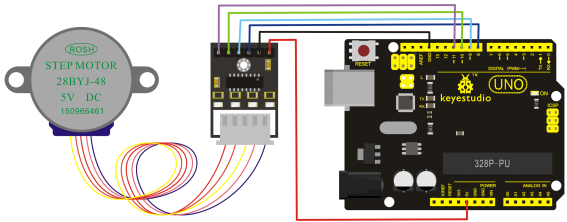
Driving Program
void setup()
{
for(int i=8;i<12;i++)
{
pinMode(i,OUTPUT);
}
}
void loop()
{
int a;
a=512;
while(a--)
{
for(int i=8;i<12;i++)
{
digitalWrite(i,1);
delay(10);
digitalWrite(i,0);
}
}
}
Test Result
After wiring and uploading the above program, you should see the stepper motor rotate slowly.
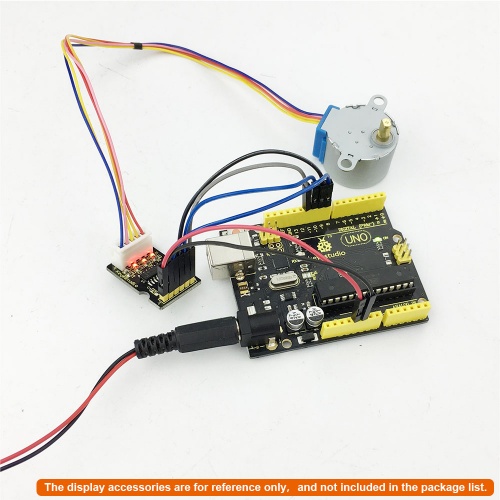
Packaging Display
- Keyestudio Stepper Motor Drive Board x 3pcs
- 5V Stepper Motor x 3pcs
Resources
